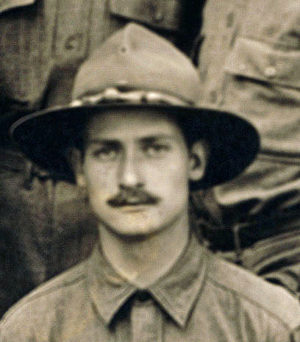(Buffalo, New York, August 2, 1894 – New York City, November 7, 1949).1
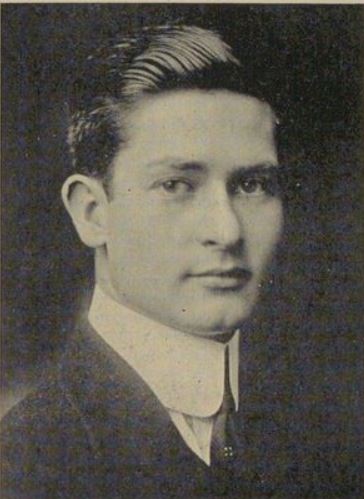
Brown’s father was an executive of the Central Electric Company in Chicago.2 After attending St. Mark’s School in Massachusetts, Brown studied at Princeton, receiving his B.A. in 1917.3 While at Princeton, he was a student at the privately funded Princeton Aviation School prior to joining the Signal Corps. He went on to attend ground school at Princeton’s School of Military Aeronautics, from which he graduated August 25, 1917.4 Princeton had planes in which aviation students received some instruction. Brown was thus probably one of those few among the second Oxford detachment who had had some flying experience prior to R.F.C. training.
Along with about half of the men in his ground school class, Brown chose or was chosen for flight training in Italy and sailed as one of the 150 men of the “Italian” or “second Oxford detachment” to England on the Carmania.5 They departed New York for Halifax on September 18, 1917, and departed Halifax as part of a convoy for the Atlantic crossing on September 21, 1917. On arrival at Liverpool October 2, 1917, the men learned that a mix-up had occurred and that they were to remain in England rather than proceeding to Italy.
The cadets (as they were now called) attended ground school (again) at the Royal Flying Corps’s No. 2 School of Military Aeronautics at Oxford. As much of their class work repeated material already covered in the U.S., the men did not have to study hard, and they enjoyed exploring Oxford and its amenities and the surrounding countryside. The War Birds entry for October 3, 1917, mentions that Brown joined Marvin Kent Curtis (with whom Brown was rooming at Christ Church College6), Clarence Horne Fry, Laurence Kingsley Callahan, and John McGavock Grider on a bicycle ride to Blenheim. Another bicycle ride taken by Brown, Uel Thomas McCurry, and Hugh Douglas Stier to a village near Oxford is commemorated in a photo kept by Grider. And Grider, in his diary, recounts how “We have a back way of getting in at night over the wall in the garden behind the college. Brownie tried to climb over the wall in the wrong place and got stuck on top of the wall. [John Hurtman] Fulford and I were coming home by way of alley & tree we heard this plaintive voice ‘Grider’ we got him down with a ladder and tucked him over the wall.”7
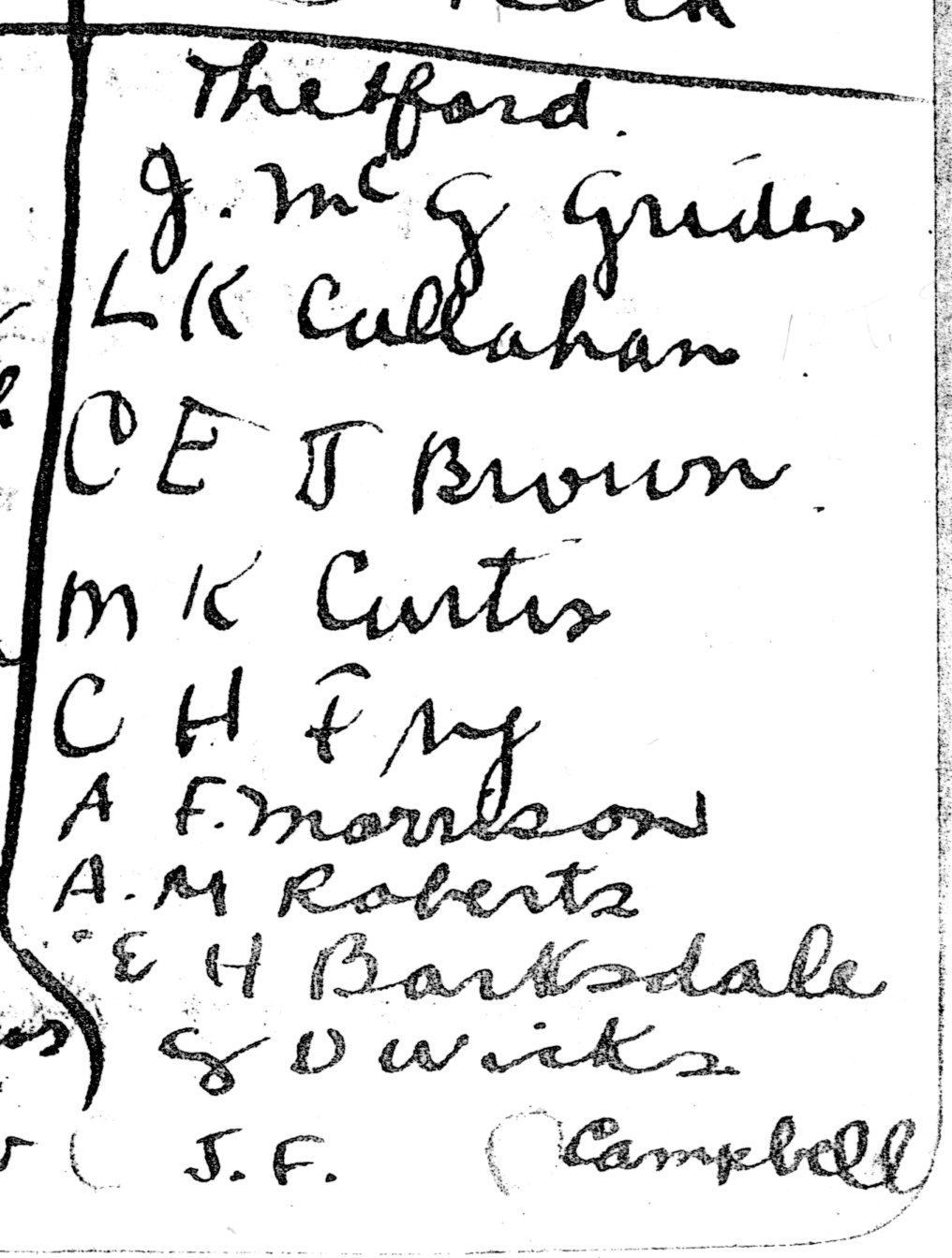
On November 3, 1917, Brown went with most of the detachment to machine gun school at Harrowby Camp, near Grantham in Lincolnshire.8 About two weeks later it was determined that fifty of the cadets could go to training squadrons, and on November 19, 1917, Brown and nine other cadets left for Thetford.9 The entry for November 17, 1917, in War Birds includes the remark: “Cal, Curtis, Brown, Fry and I [Grider] are ordered to Thetford to learn to fly at last. This is the final bust-up of the Italian Detachment.” There were at least two training squadrons at Thetford, 12 and 25; Brown, again rooming with Curtis, was presumably assigned to 12 and began his training on Maurice Farman Shorthorns.10
In mid-December 1917 Brown was posted to No. 56 Training Squadron at London Colney, where he roomed with Parr Hooper; he makes several appearances in Hooper’s letters and photos.11 The two of them spent New Year’s eve together in London, and went out to dinner in London in early February with Harold Worth Vassar of the first Oxford detachment and Arthur Richmond Taber of the second.12
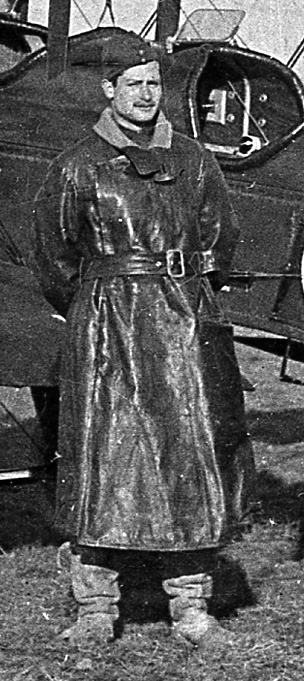
Hooper reports on January 27, 1918, that Brown has “just gone solo”; this was presumably in one of the Avros used for training at London Colney.12a Brown was probably still stationed at London Colney in early March 1918 when he landed at Hounslow where George Augustus Vaughn was training, had motor trouble, and could not get back to his own aerodrome for some time due to bad weather.13
Brown was recommended for his commission as a first lieutenant in late March 1918; Pershing’s cable forwarding the recommendation to Washington is dated March 29, 1918. As with a number of commissions, Washington took its time responding. Pershing sent a follow up on April 30, 1918: “Request action taken on paragraph 3 A my cablegram 811.” The telegram finally confirming Brown’s and others’ appointments is dated May 17, 1918.14
Around the time he received his commission, Brown was posted to Marske-by-the-Sea in North Yorkshire, where he again roomed with Curtis.15 There he trained on S.E.5s and practiced aerial combat. Curtis’s first log book entry for June 11, 1918, reads: “Fighting Brownie in an S.E.5. I sat in front seat [of Avro].” They then apparently switched planes; the next entry indicates Curtis was flying S.E.5 [D]397 and was “fighting Capt. Fielding-Johnson and Brownie in an Avro.”15a
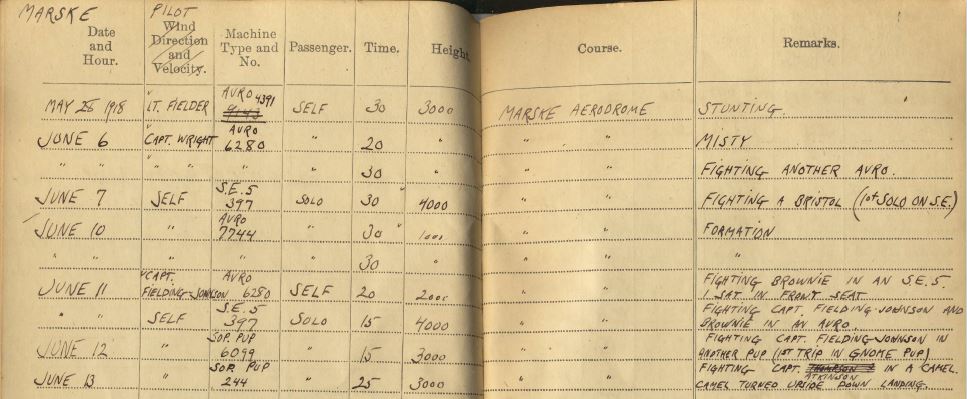
According to the biography published by Brown’s prep school, Brown, after being commissioned, “trained further and awaited assignment from July 1 to Aug 7, . . .”16 A memo dated July 30, 1918, puts Brown at the Air Service Concentration Barracks, St. Maixent.16a The school biography indicates he “was then sent to A.S. Production Centre No. 2, Romorantin, France. Served there as Ferry Pilot until Dec. 25. Arrived in the U.S.A. Feb. 5, 1919. Discharged Feb. 8, 1919.”16b A personnel list for November 11, 1918, in an Air Service document lists “C. E. Brown” (along with T. W. Blackburn and many others) as a ferry pilot.17 James J. Sloan, Jr., in his Wings of Honor, lists a Charles E. Brown as assigned post-armistice to the U.S. 166th Bombardment Squadron, having been transferred there on December 13, 1918, from Clermont Ferrand.18
After the war Brown followed his father in the electrical supply business in Chicago, eventually becoming vice president of the Okonite Company, a supplier of electrical wire and cable.19
mrsmcq April 29, 2017; updated to include detail from B.E.2c photo August 1, 2019
Notes
(For complete bibliographic entries, please consult the list of works and web pages cited.)
1 Brown’s birth date and place are taken from Ancestry.com, U.S., World War I Draft Registration Cards, 1917-1918, record for Charles Edward Brown, Jr. For his date and place of death, see “Charles Edward Brown Jr.” The photo is a detail from a group photo of Brown’s ground school class.
2 Ancestry.com, U.S. Passport Applications, 1795-1925, record for Charles Edward Brown [Sr.] (1920).
3 “Memorials.”
4 See The Princeton Bric-a-Brac 1919, p. 86 (list of students of the Princeton Aviation School); “Ground School Graduations [for August 25, 1917].” .
5 Brown’s name—like that of Leslie Benson—does not appear on the rosters of men of the second Oxford detachment in the Penttinen Collection (see “Roster. . .), and is not in the list of Oxford detachment men that Springs appended to the 1926 edition of War Birds, even though Brown is mentioned more than once in the text. Perhaps Springs conflated Brown of the second detachment with Ben E. Brown of the first. Sloan, Wings of Honor, does not include Brown’s name among the Oxford cadets, but lists him in the “Casuals Group” (p. 408). Brown’s membership in the the detachment is confirmed by the passenger lists for the Carmania’s September 18, 1917, voyage in the recently digitized War Department, Office of the Quartermaster General, Army Transport Service, Lists of Outgoing Passengers, 1917 – 1938.
6 Curtis, letter of June 10, 1918.
7 Grider, diary entry for October 30, 1917, on a page with a photo of four women, one described as “Brownie’s girl.” The wall incident is also recounted, with slightly different details, by Grider in a letter of November 1, 1917 (Grider and Jacobs, Marse John Goes to War, p. 69). Charles Edward Brown should not be confused with Edward Cecil Brown of No. 85 Squadron R.A.F. who is mentioned later in War Birds.
8 “Brown” is in the (unreliable) list of those selected in early November 1917 for flying training at Stamford that Marvin Skelton provides in his edition of Vaughn’s letters (War Flying in France, p. 28). However, Foss’s diary entry for November 15, 1917, is fairly conclusive evidence that Brown was not chosen for Stamford.
9 Hooper, Somewhere in France, letter of November 14, 1917; Foss, diary, entry for November 15, 1917.
10 Curtis, letter of June 10, 1918.
11 See Somewhere in France, Chapter 5, passim, and photos and illustrations for Chapter 5.
12 Hooper, Somewhere in France, letters of January 8 and February 10, 1918.
12a Hooper, Somewhere in France, letter of January 27, 1918.
13 Vaughn, War Flying in France, pp. 53-54.
14 See cablegrams 811-S, 1029-S, and 1337-R.
15 Curtis, letter of May 19, 1918.
15a Curtis, Pilot’s Flying Log Book.
16 Benson, Saint Mark’s School in the War Against Germany, p. 41.
16a Dwyer, “Memorandum No. 8 for Flying Officers,” p. 4.
16b Sloan, Wings of Honor, p. 408, also places Brown at Romorantin performing “ferry duty.”
17 See “History of Plant 1-A, Airplane Assembly Production & Maintenance Division, Supply Section, Air Service, American Expeditionary Forces, France,” p. 8. There is an R.A.F. service record for “C. E. Brown” that describes him as “Cadet (Obs),” without supplying any date; it also indicates assignment to “1 SofA Reading” on October 31, 1918; the record is otherwise almost completely blank. I suspect that it is for a different man.
18 Sloan, Wings of Honor, pp. 411 and 423.
19 See the obituary for Brown in “Memorials.”

